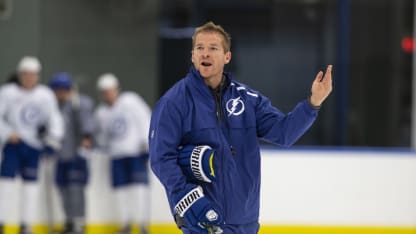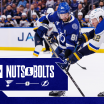While the rest of the Tampa Bay Lightning players and coaching staff have retreated to the visitors' locker room following a practice session at Boston's TD Garden, Lightning assistant coach Jeff Halpern hunches over a puck at the blue line, whistle in mouth, ready to crank another shot at the net.
Standing in front of the target with his back to Halpern is Carter Verhaeghe, a rookie centerman who led the American Hockey League for scoring a year ago (34-48-82) and made the Lightning roster out of training camp.
Halpern blows his whistle and fires.
A look inside Jeff Halpern's post-practice laboratory
Some of the Bolts' most valuable practice time comes one-on-one with assistant coach Jeff Halpern after the rest of the team has left the ice

© Scott Audette
At the sound of the whistle, Verhaeghe turns to face Halpern. In a split second he has to find the puck and bring his stick up to meet the projectile with the hopes of disrupting its trajectory and tip it into the net.
The skill is one Verhaeghe probably didn't have to showcase much last season for the Crunch. As one of the top centers in the AHL last season, his primary move wasn't to get in front of the net and look for deflections and rebounds, those greasy goals coaches so often point to when the offense is sputtering and the need to strap on the work boots arises.
Verhaeghe was a marksman allowed to showcase his skill and offensive prowess while with the Crunch.
But in Tampa Bay, after taking up residence on the Lightning's fourth line alongside brutish forwards Patrick Maroon and Luke Witkowski, Verhaeghe has had to adjust his game to adapt to the National Hockey League.
Part of that means parking his body in front of the net and willingly putting himself in the path of a projectile on the chance he can free himself enough to get his stick on a shot from the point.
Halpern is staying after the allotted practice time to help Verhaeghe improve this aspect of his game.
"Those are the old school drills," Halpern explains.
It's just Halpern and Verhaeghe on the ice now.
Halpern shoots.
Verhaeghe whirls.
Miss
One second…two…three
Repeat
Halpern shoots.
Verhaeghe whirls.
Tip
Puck bounces down and into the net
One second…two…three
Repeat
Halpern shoots.
Verhaeghe whirls.
Tip
Puck changes trajectory slightly but enough to beat even the best goalies
The two will continue this drill for the next three minutes, Halpern firing over 20 shots at Verhaeghe, the rookie getting his stick on close to three-quarters of them.
"We want to have a better net-front presence," Halpern tells me after he and Verhaeghe have wrapped up their extra work. "So that's a guy and the line he's on, they grind teams down low, pucks go to the point and for him it's, 'Can you take the goalie's eyes away and can you tip pucks in that position?' And so sometimes it's easy for a guy to stand on the side and tip pucks. It's not as easy to kind of face the puck and tip them. It was something maybe if he scores a goal tomorrow, I don't think it's me, it's something that those guys work on all the time.
"But maybe you're just reinforcing something at that time that can help him see it."
\\\\
Jeff Halpern played 976 career NHL games over 14 seasons for seven teams: Washington, Dallas, Tampa Bay, Los Angeles, Montreal, back to Washington, the New York Rangers, back to Montreal and finally Phoenix for his final season in 2013-14 at age 37.
Retirement, however, didn't signal an end to his career in the NHL.
Halpern joined the Lightning as the team's player development coach for the 2015-16 season, working closely with the organization's prospects in Syracuse. The following season, Halpern joined Benoit Groulx's staff as a full-time assistant for the Crunch, where he spent two seasons and helped lead the Crunch to the Calder Cup Final in 2017.
After the Lightning were bounced in Game 7 of the Eastern Conference Finals by the Washington Capitals in 2018, head coach Jon Cooper retooled his coaching staff, calling up Halpern from the Crunch and bringing in Derek Lalonde from the AHL's Iowa Wild. Among Halpern's many duties his first season in Tampa Bay, he was directly responsible for the power play, a unit that led the NHL and ranked 10th all-time in League history with a 28.2 percent conversion rate. That special teams group also set Lightning franchise records for power-play percentage and road power play (33.3%).
Now in his second season on the Lightning coaching staff, Halpern has added another assignment to his ever-expanding list of duties: Tampa Bay's after-hours skills coach. Halpern plays his typical role during practices and morning skates, but once the majority of players and coaches get off the ice following a training session, that's when Halpern really gets down to business.
He'll spend his time working with healthy scratches, youngsters looking to refine their game and, really, anyone who wants it.
"There's a lot of guys, and they all have different plans of things in their game that they need," Halpern said when asked what he hopes to accomplish with these after-hours sessions. "Sometimes, it's as simple as we've divided the forwards up between myself and (Lalonde), and the guys that I work with, it's parts of their game that you think are limiting them. I think for a lot of the guys on our team, systems and structure, that's kind of taken care of in video and in practice. They want to work on their offensive ability. Sometimes it's puck protection and angling and things like that. You're trying to maybe free up their hands at times, you're trying to change the way they approach a certain skill set. For me, it's a fun process because if something translates to a game, selfishly, you're proud of your work and you're proud that the guy is able to have some success with the things that you're working on or trying to point out to him. I probably have more enjoyment doing that than in the room in video or prepping for the (opponent). The joys for me are teaching the guys and working with the guys, trying to make them a better player."
Halpern isn't too far removed from his playing days, and, at age 43, he still has the look of someone who could lace up the skates and fill in for a productive shift or two.
"I think he practiced his handles a little bit this summer too," Lightning forward Mathieu Joseph joked. "He probably has more hands than when he actually played."
Taking a hands-on approach wasn't always Halpern's modus operandi as a coach. When he got his first gig in Syracuse with Groulx, he was reluctant to demonstrate as much as he does today, mainly because he wanted to be taken seriously as a coach and not as a player just trying to hang on to his past.
"I didn't want to be a player, I wanted to be a coach," Halpern said. "So, I almost purposely avoided doing stuff on the ice. I would run drills, but I wouldn't demonstrate."
But as he grew as a coach, he realized part of what could make him successful was his ability to not only explain to players the desired skill he wanted to become habit, but to demonstrate that skill and show them pointers from his own playing days, tips that helped him play nearly 1,000 games in the NHL.
"This is my fifth year coaching, you have to be able to demonstrate some of those things, you have to be able to show them how to do it, where they're going wrong, understand those things," Halpern said. "So as I've grown as a coach, I'm trying to take advantage of those moments, of being able to do some of the on-ice stuff that I enjoyed as a player, but now I'm enjoying trying to get a guy to grasp or work on."
One of Halpern's best attributes as a coach is his ability to mix up the drills he teaches. Each day, he comes up with something fresh to keep his pupils engaged.
"He always comes up with a new drill or something, a new thing that he wants us to get better with," said Lightning defenseman Jan Rutta, who, as a healthy scratch for the first 11 games of the season, has been a regular attendee at Halpern's post-practice sessions. "It's good. It's challenging."
Halpern understands how monotonous the same drills can be for a player because he lived it as a player.
For the injured guys, it sucks lining up on the goal line," he said. "When I was playing and maybe still now, guys would line up on the goal line and do a down and back, and it sucks. I think there's ways to get the same conditioning, the same speed and throw some skill stuff into it, throw some moments that actually happen in a game. And you're still making the guys work but you try to make them better too. Me and (former NHL forward) Matt Hendricks used to laugh like the more you skated as a healthy scratch or an injured player your skating got worse, you skills got worse. Sometimes you see players at the end of their careers, and it looks like they're in the middle of a bag skate, they're so programed for it. For these guys, I try to empathize with them that they're in those situations, they don't want to line up on the goal line and kind of make it miserable. They want to get better and get back in the lineup and do some of those things. And guys that are in the lineup, they want to get better and produce more and score more. As coaches, you try to have a plan every day for those guys and in the back of your mind, you know what they need help on, it's figuring out ways to bring it out of them."
\\\\
A few days after the Lightning returned to Tampa from their six-game road trip at the start of the season, Halpern stands on the ice with Joseph at the Ice Sports Forum in Brandon. The team has just completed an intense practice session focused on battle drills and competition. It was a physical, demanding practice that leaves the players sweating and gasping for air as they come off the ice and into the locker room.
But the session isn't over for Joseph.
Or Halpern
The two stay out on the ice to get some more work in. Halpern has set up five pucks in a row, spaced evenly between the top of the circles. Joseph's goal is to stickhandle through each of the pucks cleanly before firing a puck at the net. The second-year pro burst onto the scene during his rookie season because of his blazing speed, an attribute that allowed him to make the Lightning out of training camp in 2018 when a spot wasn't necessarily available. Drafted 120th overall in 2015, Joseph ranked 30th in his draft class for goals (13) last season, another mid- to late-round steal for a Lightning organization known for unearthing hidden gems in the draft. Now Joseph wants to develop the other aspects of his game to match his quickness, in this case his puck handling.
Halpern is helping him attain that goal.
"I'm know as a guy that has a lot of speed, if I can bring that to my advantage the fact that I can control the puck a little better with my speed, together, it makes a good mix," Joseph said from his locker room stall following the post-practice practice. "It's definitely something I've been working on. I think he's helping guys. Sometimes there's some stuff we really don't have time to practice during actual practice with the team, so we do that before or after. Sometimes in games, you don't even have a lot of possession with the puck, so when you have it you want to make the best out of it. That's what I'm trying to do."
Halpern said he gets the most satisfaction out of his job when he works on a skill repeatedly with a player after practice and that skill translates into a game.
It's the feeling of accomplishment, the reinforcement that hard work does, in fact, pay off.
"I think Mathieu Joseph is, not that a coach is, but he's come back and he's worked on his game and he's kind of worked on, he used to be a guy, he really only played on the left side of his body so he's done things, he's changed his stick, he's changed his curve and it's stuff that we've been able to work on together where he's able to kind of move to the other side of his body with a little more fluidity and I think it's opened up his game. It hasn't translated necessarily to a million points, but when you watch him, he's not stuck in that position. He's kind of freeing himself up. It's not perfect but you can see him working on it, you can see him trying to do it when it comes up in a game and it is a moment where as a coach you're happy about it and you want to see it grow and improve."


















